Deeply curious, we started to ask people their opinions on 3D printing. With time, we came to the conclusion that we had been asking the wrong questions. At a time when 3D printing is anything but new, still in most cases people had never really met the term 3D printing at all. Not everybody needs explanations of course, but for those who do, we are more than happy to oblige.
3D PRINTING DOESN’T END ON PAPER
The first important fact is that 3D printing has nothing to do with printing on paper or other flat surfaces. 3D printing ends with real objects. To be more accurate, 3D printing is a process of materializing any three-dimensional (3D) idea into tangible three-dimensional (3D) objects. This technology is also known as additive manufacture, which represents the production of objects through adding material (in this case building layers on top of layers) in contrast to standard methods of production where extra material is usually removed to create an object. 3D printing starts with the creation of digital 3D data based on an idea, continues with processing and cleaning the 3D data in a special 3D graphics software, and ends with materializing the 3D data into detailed physical objects using a special 3D printing machine (3D printer). Depending on the 3D printer and the material used for 3D printing, sometimes manual post-production is needed.
3D PRINTERS VARY TREMENDOUSLY
Many of us are confused by what we can expect from the 3D printing phenomenon, which is the current technological hot topic. One day we read about the newest cutting-edge machine for EUR 70,000 or even EUR 200,000, and the next day our neighbour tells us he owns a 3D printer himself. It might be a machine for EUR 500 – 1,500 for domestic use only… Every printer is good for something, but the difference between them is huge. 3D printers vary in quality, size, structure, printing materials, colour options, printing times, resolutions, minimum feature sizes, maximum build sizes, vertical build speed, minimum layer thickness, equipment specifications and other requirements such as application purpose. Some machines are better for colourful marketing and entertainment objects, some for domestic or even everyday use, prototype construction, product development, design ideas, architectural presentations, healthcare solutions, etc.
MATERIALS FOR 3D PRINTING LEAVE US OPEN MOUTHED
Different 3D printers use different materials for 3D printing.
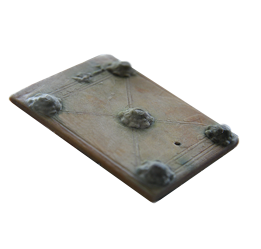 COMPOSITE
COMPOSITE
ZPrinter 650 (3D Systems ProJet 660Pro) for example uses gypsum composite, also known as “sandstone”. With characteristics such as printing in full-colour CMYK scale, minimum layer thickness 0.08 mm, and price starting from EUR 0.8 / cm3, it is one of the fastest professional 3D printers that allows printing in multicolour and high detail, while keeping costs low. Depending on the finalization, the composite can be very rigid or very delicate.
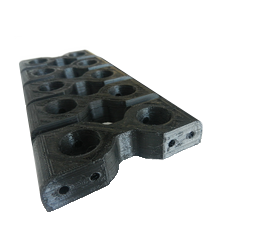 PLASTICS
PLASTICS
Filament machines such as Leapfrog Creatr, Ultimaker or MarkerBot Replicator use plastic polymers PLA or ABS which are quite solid and slightly flexible, with one or two colours to print, minimum layer thickness 0.1 – 0.2 mm and prices around EUR 0.3 – 0.7 / cm3. Filaments are therefore very popular with the general public. However, ABS plastic – also known as LEGO plastic – can be found on the domestic as well as professional level of production.
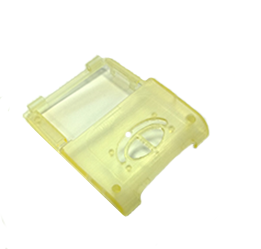 PHOTOPOLYMERS
PHOTOPOLYMERS
Objet 3D printers use transparent or opaque tinted acrylic-based photopolymers, with either solid or flexible properties. Depending on what you need, this material is capable of minimum layer thickness 0.02 mm, which means remarkable precision. With higher precision, rigidity or flexibility, the prices rise accordingly.
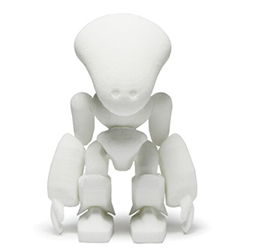 POLYAMIDE
POLYAMIDE
Another highly professional, strong, flexible and durable material is polyamide with minimum layer thickness 0.1 – 0.15 mm. Polyamide 3D objects are created on EOS machines with “Selective Laser Sintering” (SLS), the process of melting and welding the plastic powder by laser. SLS is not actually a 3D printing process, but is its direct competitor. Polyamids’ brother, Alumid, is created the same way, but blended with aluminium powder to give its metallic look.
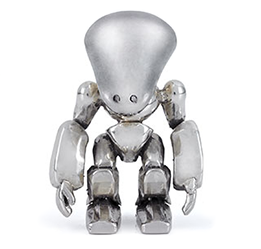 OTHERS
OTHERS
For those interested in 3D printing, the possibilities of even more fascinating materials will come as no surprise. Apart from gypsum, plastics, photopolymers and polyamide, it is standard to print from resin, wax, ceramics, paper and strong metals like steel, brass, silver, bronze, gold and the strongest of all, titanium. Materials combining powdered proteins, carbohydrates and sugars can print edible food like pizza, pasta, and candies. Even custom chocolate printing is almost commonplace today. And last but not least, the most ground-breaking news about progress in 3D bio printing – replicating biological tissue by printing cells – is spreading around the world every single day. Still confused about which method to choose? Give us a call, or come for a coffee and let us explain more.
Image source: SKYFORM, Sculpteo


Thanks for your very informative discuss!
This is huge and very fascinating.
Any idea or suggestions about what it would take or mean to 3D print a life size mannequin? Material? Type and size of printer? Availability and Costs? Etc. Etc.
Hi Victor,
thanks for your interest, it is really nice to see enthusiastic people.
We’ve already printed a human torso (as a shell) with the full-colour gypsum composite printer ZPrinter 650 (3D Systems ProJet 660Pro) and it took us about a week to print and finish. For the whole body (17 000 cm2 on average) it would take approximately two weeks. It is recommended to print only a 0.5 – 1 cm shell to save time and material. The mannequin would have to be printed by parts and then assembled or glued together as the maximum build size is 254 x 381 x 203 mm. The price depends on the quality of the data, the volume of the material used and the difficulty of the postproduction process. Also it depends on whether the mannequin is static or whether the limbs require joints. I hope this answers all your questions. Regarding the costs I will leave you a private message on your email.